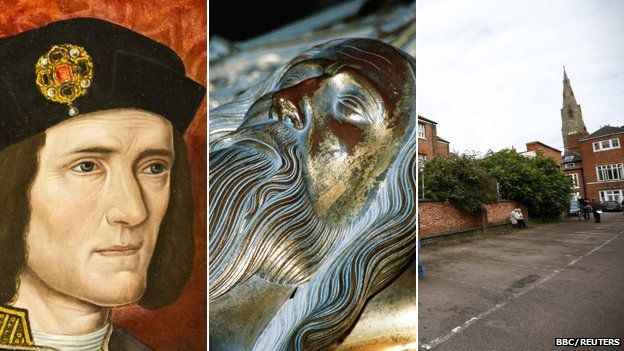Richard III dig: How search reached Leicester car park
- Published

A council car park in Leicester is not where you would expect to find one of England's most notorious kings.
But years of painstaking research, a globe-trotting trail of clues and cutting edge technology - along with an awkward phone call - have led a team of experts to this unglamorous spot near the city's ring road.
And they hope within touching distance of the lost grave of King Richard III.
Richard was killed in battle in 1485, an event which ended the bloody civil war known as the Wars of the Roses.
The royal family which defeated him, the Tudors, ensured he was remembered as a black-hearted villain, capable of killing family and friends.
But a loyal band of enthusiasts have worked hard to rescue the last Plantagenet king's battered reputation - and recover his lost remains.
It was known his body was dragged from the battlefield and exhibited in Leicester to show the public he was truly dead.
Historian Dr John Ashdown-Hill, author of The Last Days of Richard III, combed archives for clues to his eventual burial site.
"I uncovered an account in the financial records of Henry VII where he set aside money to pay for an alabaster tomb for Richard.
"This said the tomb should be built over his grave, in the Choir of Greyfriars church. So we had a specific place."
But where one problem was answered, another remained.
Greyfriars was demolished during the religious reforms of Henry VIII and one widely accepted story had Richard's bones being tipped into the local river.
Again Dr Ashdown-Hill's research came to the rescue.
He found the tale came from a 17th Century map-maker called John Speede who had also looked for the grave.
"Looking at Speede's map, he had misidentified Greyfriars, which was actually the separate Blackfriars. He was looking in the wrong place.
"He perhaps used the story of the grave being emptied to cover for the fact he could not find it."
But Dr Ashdown-Hill's next contribution was perhaps the most astonishing. He just happened to have Richard III's family DNA.
Years earlier he had managed to trace descendants of Richard's sister, Anne of York.
"I started the family tree, which quickly turned into an enormous spider's web.
"There were dozens of lines of descent but it was very frustrating as you would follow a line for years and so many of them went into the 19th Century and then died out."
Against the odds, after three years of searching, he succeeded in tracing a living relative in Canada.
"It was an odd feeling being about to make such a phone call," he said. "They might think you are a lunatic and put the phone down."
But the woman agreed to give a DNA sample, which, thanks to an unbroken female link to the 15th Century House of York, meant any bones could be positively identified.
Events took a decisive turn when Dr Ashdown-Hill met Philippa Langley, from the Richard III Society, who had been trying to get backing for a search for the lost king's remains.
Ms Langley said: "Because of the work of Dr Ashdown-Hill, with his DNA work, when we put that into the conversation, the authorities thought: 'Ok, these guys are serious'."
But this still left the small point of actually finding the church, levelled more than 500 years ago.
So she approached archaeologists at the University of Leicester, headed by Richard Buckley.
Ms Langley said: "He went off and did the map analysis and it was that which clinched it, because he came back and said 'Look I think you are right. I think this is telling us something'.
"After that it all snowballed."
'Quite a tingle'
Self-confessed sceptic Mr Buckley said he took some time to accept the idea.
"To be truthful I did roll my eyes slightly at first," he said. "In archaeology you aren't supposed to look for famous people."
On 25 August, machines broke through the surface of the Greyfriars car park in Leicester.
"It was surreal," said Ms Langley. "Three years of hard work and I thought 'Am I really seeing this? Am I really seeing Leicester City Council allowing us to rip up their car park?'
"I kept thinking someone was going to come out and shout 'Stop!'."
Mr Buckley said the first week exceeded expectations. Just two trenches produced pieces of window and tile which could only have come from a high-status building.
A third trench then helped to identify the walls of the church. Were they closing in on Richard?
Mr Buckley said: "The remaining hurdles are whether there are any burials in the church, whether there are any in the choir and if so, are they the one we want?
"Although at the beginning you think 'There is no way we are going to get anywhere near it', but actually we are getting quite near it, if it's there. It is quite a tingle."
While the final results of the excavation are a still a closely guarded secret, an open day at the dig site is being held on Saturday.